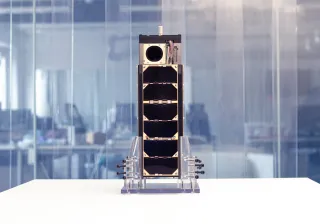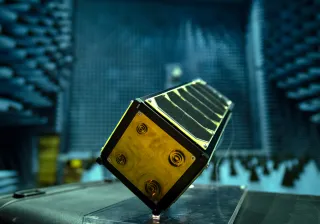The telecommunication system of the future is a multifaceted whole, combining 5G mobile networks with satellite networks in space and low Earth orbit. The flexible and reliable connections and powerful data transfer can be utilised particularly on moving objects and in scarcely populated areas, envisions VTT's new "5G and Beyond for New Space" publication.
The vision of the future of telecommunications is a result of co-operation between VTT, the European Space Agency ESA and two German research organisations. – VTT has an understanding of what is needed for the telecommunications of the future and the ability to implement these technologies. The cooperation shows trust in our know-how, says Marko Höyhtyä, who coordinates space technology research activities at VTT.
Reliable connections on land, sea and air
5G mobile networks and satellite networks connected to them are suitable for applications where traditional connections are insufficient. Such applications include many mobile systems from cars to ships and aeroplanes, as well as various work machines or industrial equipment.
Terrestrial connections can provide service to these systems, for example in the harbour area or at the airport, but farther from the shore or up in the air, they require support from satellites and drones.
Good telecommunication connections that are reliable in all conditions enable, for example, autonomous vehicles, self-navigating maritime traffic, or the remote operation of various work machines also on difficult to access sites.
Scarcely populated areas will benefit
Combining the 5G mobile network with satellite networks benefits scarcely populated areas. It is not worth it to build a comprehensive terrestrial network in the Arctic Region or the wilderness, but data transfer can be ensured with satellites in these areas, too.
The authorities are one key user group of the information networks of the future. The new connections offer an alternative to the public authority networks, the poor data transfer capacity of which limits, for example, the sending of images or video. In the future, sensor data collected from a border zone, for example, can be relayed via a satellite to a control room, allowing the sending of a drone to investigate the situation when necessary.
– Drones and satellites can also photograph the environment and provide data that allows the authorities to identify hazardous situations. This allows them to react to, for example, a starting forest fire quicker than today. On the other hand, satellites provide help and reserve connections in situations where a fire, earthquake or some other natural catastrophe has destroyed fixed networks.
Research paves the way towards the vision
The realisation of the vision faces technological challenges that can be overcome with the help of research. Optical connections, for example, are a promising technology that is currently not much utilised. Optical connections consume just a little power, transfer data rapidly, and are suitable for data transfer between satellites, for example. In order to achieve these benefits, the technology must be developed further.
Another challenge the multidimensional network faces is related to intelligent routing. The system should be able to automatically choose the route that is best suited for each purpose as well as being reliable and correctly priced. More information is also needed on disruption management, the operation of the connections in different frequency bandwidths, and the information security of the multidimensional system.
'These challenges provide a perspective on where the research should be directed and how the technology needs to be developed, Mr Höyhtyä says. 'Additionally, the development of telecommunication networks must take international regulations and the commercial aspect into consideration. The system must attract a sufficient number of commercial services in order for the system we have envisioned to become reality. All signs point to this being possible.'
VTT's space research is also demonstrated more extensively at the Finnish Satellite Workshop event in Espoo on 20-22 January 2020.




